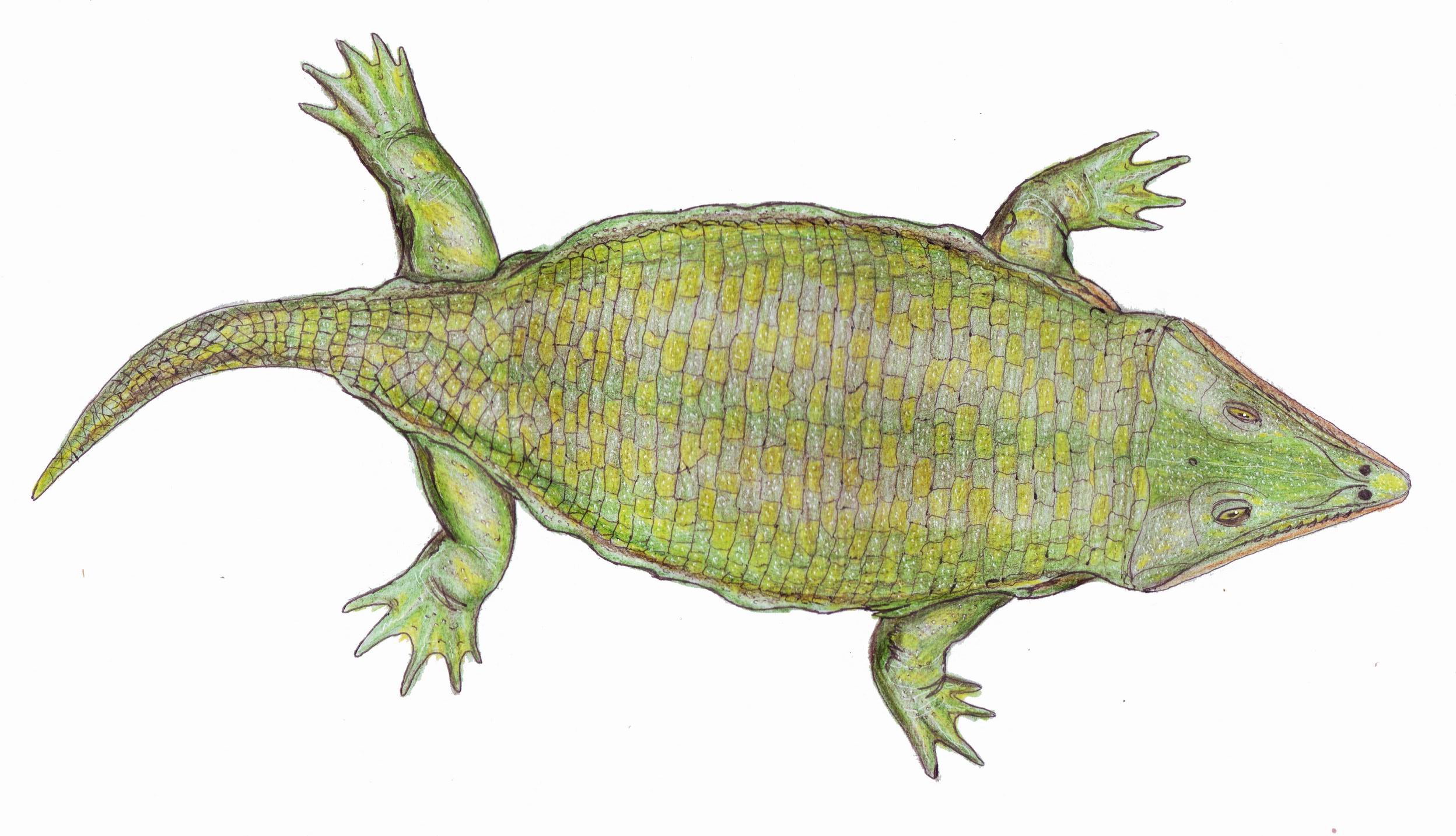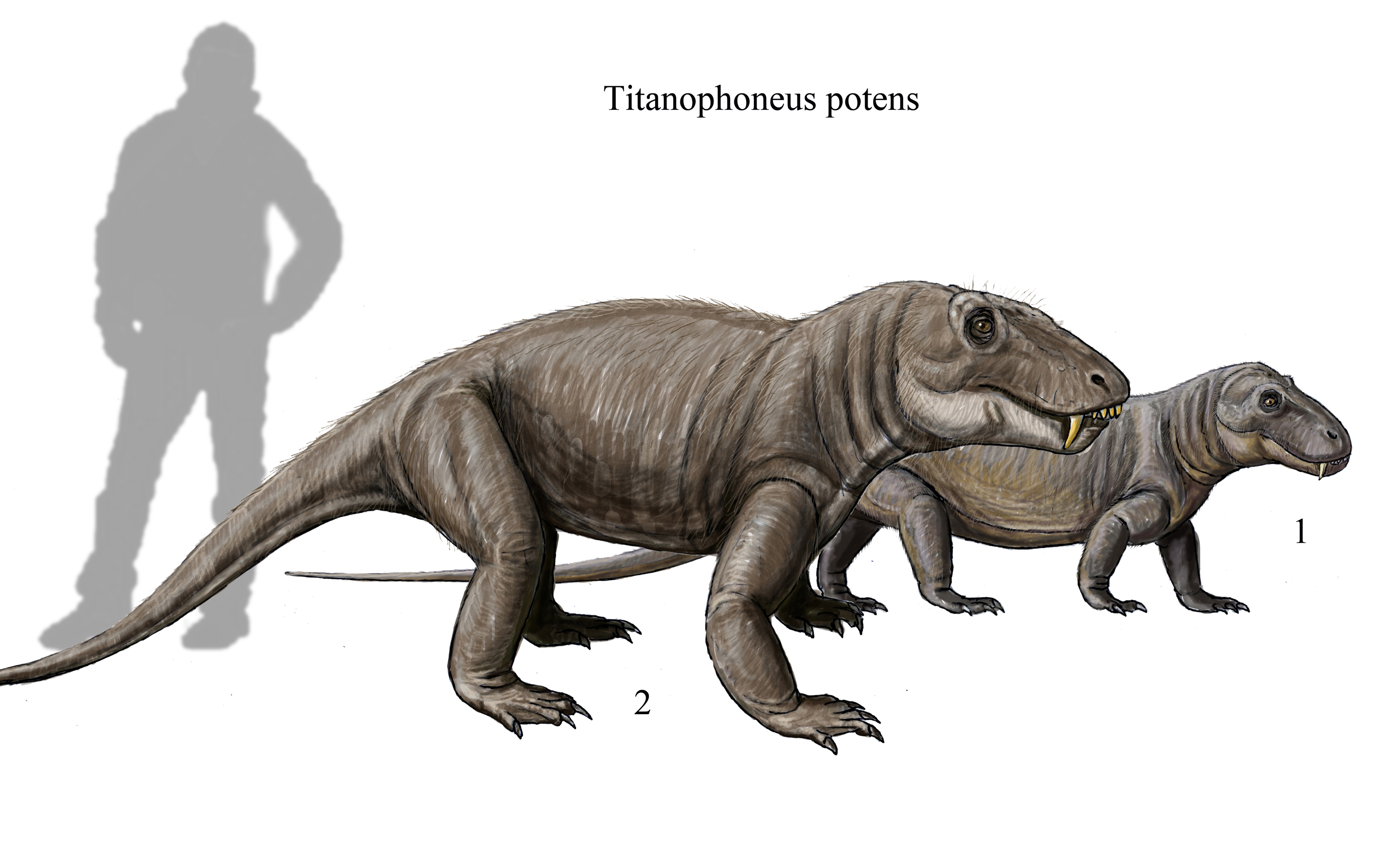|
Fayella
''Fayella'' is an extinct genus of dubious temnospondyl from the Early Permian (Guadalupian) of Oklahoma. Taxonomy The holotype of ''Fayella chickashaensis'', FMNH UR 1004, comprises a brain case with part of basicraium, basipterygoid processes, and part of otic complex. It was found in the Chickasha Formation of Oklahoma. Olson (1972) referred a complete specimen (UCLA VP 3066) to ''Fayella'' based on cranial similarities. However, Gee et al. (2018) declared ''Fayella'' a ''nomen dubium'', assigning it to Temnospondyli indeterminate and coining '' Nooxobeia'' for UCLA VP 3066, which is definitely a dissorophid.Bryan M. Gee; Diane Scott; Robert R. Reisz (2018). "Reappraisal of the Permian dissorophid Fayella chickashaensis". Canadian Journal of Earth Sciences. 55 (10): 1103–1114. doi:10.1139/cjes-2018-0053. See also * Prehistoric amphibian * List of prehistoric amphibians This list of prehistoric amphibians is an attempt to create a comprehensive listing of all genera from t ... [...More Info...] [...Related Items...] OR: [Wikipedia] [Google] [Baidu] |
Nooxobeia
''Nooxobeia'' is an extinct genus of dissorophid temnospondyl from the Early Permian (Guadalupian) of Oklahoma. The generic name is derived from the Arapaho (a language spoken in the type locality of the holotype) word ''nooxobe'', which means frog. Taxonomy Olson (1972) referred a complete dissorophid specimen (UCLA VP 3066) from the Chickasha Formation of Oklahoma to '' Fayella chickashaensis'' based on cranial similarities to the holotype. However, in 2018, Gee, Scott and Reisz declared ''Fayella'' a ''nomen dubium'' and an indeterminate temnospondyl, and made UCLA VP 3066 the holotype of the new species ''Nooxobeia gracilis''. See also * Prehistoric amphibian * List of prehistoric amphibians This list of prehistoric amphibians is an attempt to create a comprehensive listing of all genera from the fossil record that have ever been considered to be amphibians, excluding purely vernacular terms. The list includes all commonly accepted g ... References Dissorophids ... [...More Info...] [...Related Items...] OR: [Wikipedia] [Google] [Baidu] |
Dissorophids
Dissorophidae is an extinct family of medium-sized, temnospondyl amphibians that flourished during the late Carboniferous and early Permian periods. The clade is known almost exclusively from North America. History of study Dissorophidae is a diverse clade that was named in 1902 by George A. Boulenger. Junior synonyms include Otocoelidae, Stegopidae, and Aspidosauridae. Early in the study of dissorophoids when the relationships of different taxa were not well-resolved and most taxa had not been described, Dissorophidae sometimes came to include taxa that are now not regarded as dissorophids and may have excluded earlier described taxa that are now regarded as dissorophids. Amphibamiforms were widely regarded as small-bodied dissorophids, and at one point, Dissorophidae was also suggested to also include Trematopidae. 19th century In 1895, American paleontologist Edward Drinker Cope named ''Dissorophus'' from the early Permian of Texas. This was the first dissorophid to be ... [...More Info...] [...Related Items...] OR: [Wikipedia] [Google] [Baidu] |
Temnospondyl
Temnospondyli (from Greek language, Greek τέμνειν, ''temnein'' 'to cut' and σπόνδυλος, ''spondylos'' 'vertebra') is a diverse order (biology), order of small to giant tetrapods—often considered Labyrinthodontia, primitive amphibians—that flourished worldwide during the Carboniferous, Permian, and Triassic periods. A few species continued into the Jurassic and Cretaceous periods. Fossils have been found on every continent. During about 210 million years of evolutionary history, they adapted to a wide range of habitats, including freshwater, terrestrial, and even coastal marine environments. Their life history is well understood, with fossils known from the larval stage, metamorphosis, and maturity. Most temnospondyls were semiaquatic, although some were almost fully terrestrial, returning to the water only to breed. These temnospondyls were some of the first vertebrates fully adapted to life on land. Although temnospondyls are considered amphibians, many had cha ... [...More Info...] [...Related Items...] OR: [Wikipedia] [Google] [Baidu] |
Prehistoric Amphibian
This list of prehistoric amphibians is an attempt to create a comprehensive listing of all Genus, genera from the fossil record that have ever been considered to be amphibians, excluding purely vernacular terms. The list includes all commonly accepted genera, but also genera that are now considered invalid, doubtful (''nomen dubium, nomina dubia''), or were not formally published (''nomen nudum, nomina nuda''), as well as synonym (zoology), junior synonyms of more established names, and genera that are no longer considered amphibians. Modern forms are excluded from this list. The list currently includes 454 names. Naming conventions and terminology Naming conventions and terminology follow the International Code of Zoological Nomenclature. Technical terms used include: * Synonym (zoology), Junior synonym: A name which describes the same taxon as a previously published name. If two or more genera are formally designated and the type (zoology), type specimens are later assigned to th ... [...More Info...] [...Related Items...] OR: [Wikipedia] [Google] [Baidu] |
List Of Prehistoric Amphibians
This list of prehistoric amphibians is an attempt to create a comprehensive listing of all genera from the fossil record that have ever been considered to be amphibians, excluding purely vernacular terms. The list includes all commonly accepted genera, but also genera that are now considered invalid, doubtful ('' nomina dubia''), or were not formally published (''nomina nuda''), as well as junior synonyms of more established names, and genera that are no longer considered amphibians. Modern forms are excluded from this list. The list currently includes 454 names. Naming conventions and terminology Naming conventions and terminology follow the International Code of Zoological Nomenclature. Technical terms used include: * Junior synonym: A name which describes the same taxon as a previously published name. If two or more genera are formally designated and the type specimens are later assigned to the same genus, the first to be published (in chronological order) is the senior synon ... [...More Info...] [...Related Items...] OR: [Wikipedia] [Google] [Baidu] |
Early Permian
01 or '01 may refer to: * The year 2001, or any year ending with 01 * The month of January * 1 (number) Music * '01 (Richard Müller album), 01'' (Richard Müller album), 2001 * 01 (Son of Dave album), ''01'' (Son of Dave album), 2000 * 01 (Urban Zakapa album), ''01'' (Urban Zakapa album), 2011 * O1 (Hiroyuki Sawano album), ''O1'' (Hiroyuki Sawano album), 2015 * 01011001, the seventh studio album from Arjen Anthony Lucassen's Ayreon project Other uses * 01 (telephone number), United Kingdom internal dialing code for London between the late 1950s and 1990 * Lynk & Co 01, a compact SUV built since 2017 * Zero One also known as ''Machine City'', a city-state from the ''The Matrix (series), Matrix'' series * Kolmogorov's zero-one law, a law of probability theory * Pro Wrestling ZERO1-MAX, a wrestling promotion formerly known as Pro Wrestling ZERO-ONE * BAR 01, a Formula One chassis * The number of the French department Ain * The codename given to the Wing Gundam by Oz in the anime ''G ... [...More Info...] [...Related Items...] OR: [Wikipedia] [Google] [Baidu] |
1965 In Paleontology
Archosauromorphs Newly named non-avian dinosaurs Data courtesy of George Olshevsky's dinosaur genera list. Newly named birds Plesiosaurs New taxa References {{Reflist, 30em Paleontology Paleontology (), also spelled palaeontology or palæontology, is the scientific study of life that existed prior to, and sometimes including, the start of the Holocene epoch (roughly 11,700 years before present). It includes the study of fossi ... Paleontology 5 ... [...More Info...] [...Related Items...] OR: [Wikipedia] [Google] [Baidu] |
Type Species
In zoological nomenclature, a type species (''species typica'') is the species name with which the name of a genus or subgenus is considered to be permanently taxonomically associated, i.e., the species that contains the biological type specimen(s). Article 67.1 A similar concept is used for suprageneric groups and called a type genus. In botanical nomenclature, these terms have no formal standing under the code of nomenclature, but are sometimes borrowed from zoological nomenclature. In botany, the type of a genus name is a specimen (or, rarely, an illustration) which is also the type of a species name. The species name that has that type can also be referred to as the type of the genus name. Names of genus and family ranks, the various subdivisions of those ranks, and some higher-rank names based on genus names, have such types. [...More Info...] [...Related Items...] OR: [Wikipedia] [Google] [Baidu] |
Genus
Genus ( plural genera ) is a taxonomic rank used in the biological classification of extant taxon, living and fossil organisms as well as Virus classification#ICTV classification, viruses. In the hierarchy of biological classification, genus comes above species and below family (taxonomy), family. In binomial nomenclature, the genus name forms the first part of the binomial species name for each species within the genus. :E.g. ''Panthera leo'' (lion) and ''Panthera onca'' (jaguar) are two species within the genus ''Panthera''. ''Panthera'' is a genus within the family Felidae. The composition of a genus is determined by taxonomy (biology), taxonomists. The standards for genus classification are not strictly codified, so different authorities often produce different classifications for genera. There are some general practices used, however, including the idea that a newly defined genus should fulfill these three criteria to be descriptively useful: # monophyly – all descendants ... [...More Info...] [...Related Items...] OR: [Wikipedia] [Google] [Baidu] |
Guadalupian
The Guadalupian is the second and middle series/epoch of the Permian. The Guadalupian was preceded by the Cisuralian and followed by the Lopingian. It is named after the Guadalupe Mountains of New Mexico and Texas, and dates between 272.95 ± 0.5 – 259.1 ± 0.4 Mya. The series saw the rise of the therapsids, a minor extinction event called Olson's Extinction and a significant mass extinction called the end-Capitanian extinction event. The Guadalupian was previously known as the Middle Permian. Name and background The Guadalupian is the second and middle series or epoch of the Permian. Previously called Middle Permian, the name of this epoch is part of a revision of Permian stratigraphy for standard global correlation. The name "Guadalupian" was first proposed in the early 1900s, and approved by the International Subcommission on Permian Stratigraphy in 1996. References to the Middle Permian still exist. The Guadalupian was preceded by the Cisuralian and followed by the Lop ... [...More Info...] [...Related Items...] OR: [Wikipedia] [Google] [Baidu] |
Chickasha Formation
The Chickasha Formation is a geologic formation in Oklahoma. It preserves fossils dating back to the Permian period. See also * List of fossiliferous stratigraphic units in Oklahoma * Paleontology in Oklahoma Paleontology in Oklahoma refers to paleontological research occurring within or conducted by people from the U.S. state of Oklahoma. Oklahoma has a rich fossil record spanning all three eras of the Phanerozoic Eon. Oklahoma is the best source of ... References * Permian geology of Oklahoma {{Permian-stub ... [...More Info...] [...Related Items...] OR: [Wikipedia] [Google] [Baidu] |
Cisuralian Temnospondyls Of North America
The Cisuralian is the first series/epoch of the Permian. The Cisuralian was preceded by the Pennsylvanian and followed by the Guadalupian. The Cisuralian Epoch is named after the western slopes of the Ural Mountains in Russia and Kazakhstan and dates between 298.9 ± 0.15 – 272.3 ± 0.5 Mya. The Cisuralian is often synonymous with the informal terms early Permian or lower Permian. It corresponds approximately with the Wolfcampian in southwestern North America. The series saw the appearance of beetles and flies and was a relatively stable warming period of about 21 million years. Name and background The Cisuralian is the first series or epoch of the Permian. The Cisuralian was preceded by the last Pennsylvanian epoch (Gzhelian) and is followed by the Permian Guadalupian Epoch. The name "Cisuralian" was proposed in 1982, and approved by the International Subcommission on Permian Stratigraphy in 1996. The Cisuralian Epoch is named after the western slopes of the Ural Mountain ... [...More Info...] [...Related Items...] OR: [Wikipedia] [Google] [Baidu] |

_(2).jpg)

